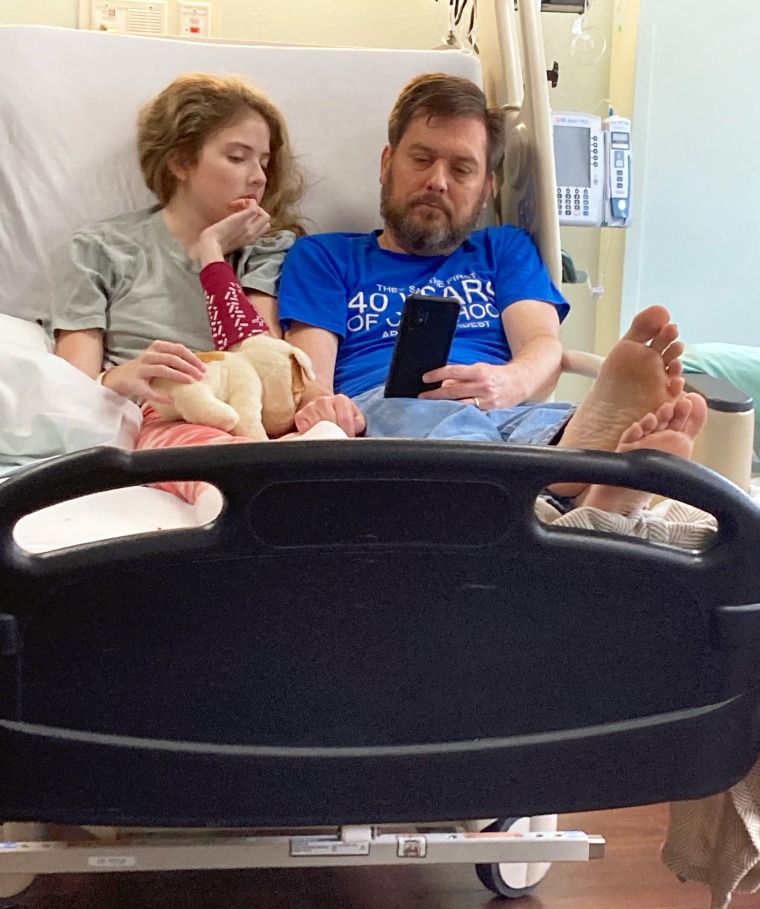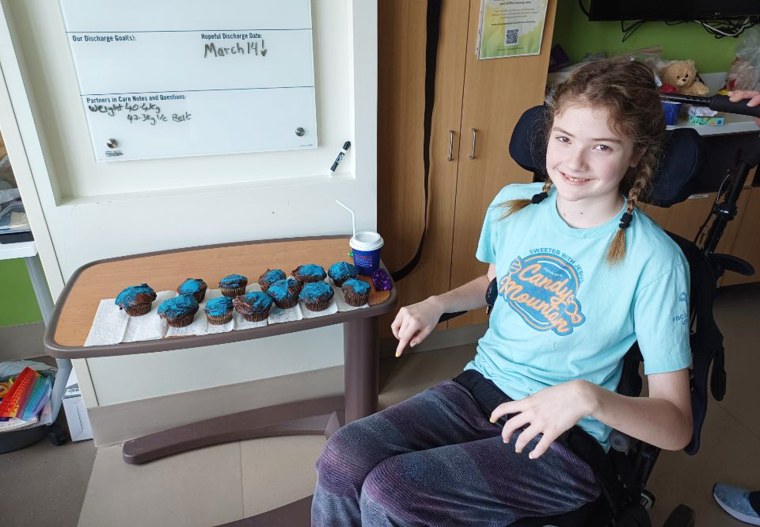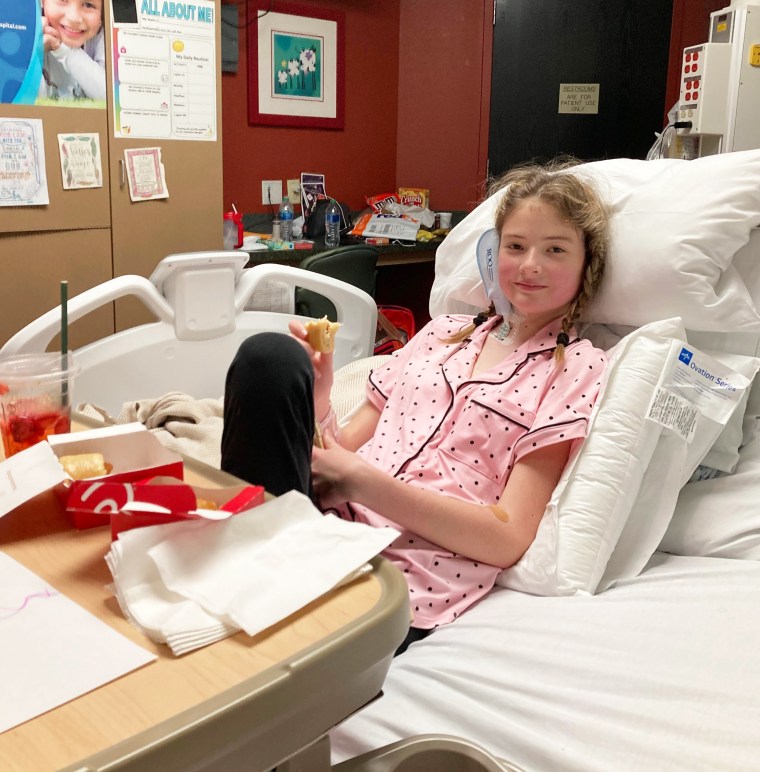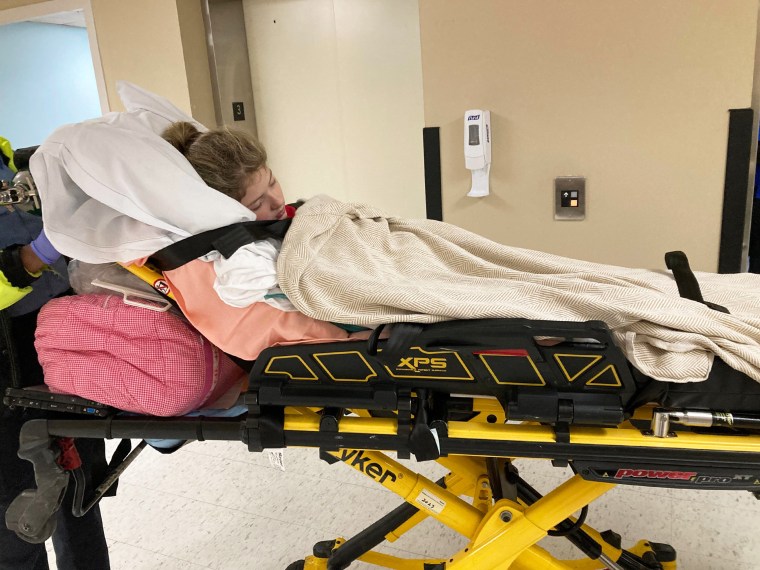Earlier this year, Hallie Hale, 13, suddenly became clumsy, dropping things and struggling to do activities with her left side. A fall in the bathroom caused her parents serious panic.
“She was sitting down on the toilet. I was trying to talk to her, and she finally said, ‘I can’t see you and I can’t hear you,’” her dad, Dathan Hale, tells TODAY.com. “The first thing that hit my mind — it’s a stroke.”

When the ambulance arrived, Hallie experienced more stroke symptoms, including facial drooping on her left side, and they called for helicopter to take Hallie to the hospital. But she didn’t have a stroke — it was a rare autoimmune disorder that causes brain inflammation called anti-NMDA receptor encephalitis. Before improving, she experienced terrifying hallucinations.
"We've never faced anything like this," Dathan Hale says.
Dropping things, difficulty doing small tasks
Hallie loved dancing. When she wasn’t taking classes for three hours a week, she was at home practicing and doing barre videos. In January, her parents noticed she was struggling to hold things, fold towels or fix her makeup and hair.
“We were going to take her to the pediatrician because, honestly, we thought she had a pinched nerve,” Sarah Beth Hale, Hallie’s mom, tells TODAY.com. “Her left side was bothering her.”
On Jan. 23, 2023, the Hales found out just how badly their daughter needed medical attention, when Halle fell in her parents' bathroom.
“I heard a crash. I was sitting on the bed, and I asked if she was OK,” Sarah Beth Hale recalls. “She didn’t respond. As I was headed toward the bathroom, she started screaming.”
Hallie was wedged between the wall and the toilet. Her parents got her to sit on the toilet as they prepared to take her to the emergency room. They decided to call an ambulance after Hallie said she couldn’t see or hear them.
“She was sweating profusely, like her whole body was just drenched in sweat,” Sarah Beth Hale says. “She had a twitch in her left eye that the paramedics saw. They saw her hand had a tremor.”

On the way to the hospital, Hallie's face began drooping, and the paramedics thought it would be better to call a helicopter to transport her to Orlando Health Arnold Palmer Hospital for Children. Doctors ordered a slew of tests, bloodwork, an MRI and a CT scan when she arrived.
“They didn’t dismiss it. She was still having tremors on the left side,” Sarah Beth Hale says. “She was still struggling.”
The next day, the family met with Dr. Vikram Prakash, who ordered a brain activity scan.
“There was an abnormality,” Sarah Beth Hale says. “It showed that the right side of her brain was slower than her left side, which was causing all the things on the left side.”
Prakash ordered another MRI with contrast. But the MRI came back as normal.
Doctors diagnosed her with hemiplegic migraines — migraines associated with weakness on one side of the body — and sent her home with follow-up appointments. Exhausted from their hospital stay, Sarah Beth Hale and Hallie took a nap. When Hallie awoke, she felt “very confused.”
“She started playing with her clothes. She’s very agitated. She didn’t know what day it was,” Sarah Beth Hale recalls. “I freaked out because I’ve never seen her like that.”

They called 911, and paramedics evaluated her and consulted with doctors, and they advised the Hales to monitor Hallie.
“The next day, she started to see things that weren’t there. It started with her saying, ‘Hey look, you have a big mouth. Your eyes are really big,’” Dathan Hale says. “It was like she was seeing things bigger than they were.”
Then, Hallie saw a man that wasn’t there. They called Prakash, and he wondered if she was having seizures and asked for the family to bring Hallie back to see him. But before that, Hallie’s hallucinations took a terrifying turn.
“She saw another man, and this man had a sword and she felt like he was stabbing her,” Sarah Beth Hale says.
They returned to the emergency room, and soon after she was admitted. Prakash stopped by and ordered another brain scan. He pulled Sarah Beth and Dathan Hale aside because he suspected what Hallie had, and he wanted to treat it aggressively and immediately.
“They did two different procedures. The first was to insert a catheter into her jugular vein,” Sarah Beth Hale explains. “The other thing they did was a lumbar puncture, where they took her spinal fluid and that was sent off to the Mayo Clinic.”

Anti-NMDA encephalitis
Anti-NMDA encephalitis is a rare autoimmune condition where the body makes antibodies that attack the NMDA receptor in the brain. This can lead to scary personality changes.
“NMDA receptor is an important part of the brain, which plays a big role in memory, emotions,” Prakash, a pediatric neurologist at Orlando Health Arnold Palmer Hospital for Children, tells TODAY.com.
Anti-NMDA encephalitis can lead to physical and mental symptoms, such as seizures or visual and auditory hallucinations, Prakash says.
At various points, Hallie's parents thought she was experiencing seizures up to three times a day due to her tremors, but they weren't "traditional" seizures, Dathan Hale recalls. “It was more relaxed, spaced out. She was able to talk to you. She would have some involuntary movements at times.”
About 60% of patients develop anti-NMDA because of a benign tumor growing in their bodies that the immune system tries to fight, according to Prakash. Hallie did not have a tumor, but she received the same treatment as those that do.
Doctors removed the antibodies attacking her brain through a treatment called plasmapheresis and then did an infusion with new antibodies, called IVIG, to block the attacking antibodies. Doctors can follow this with another type of antibody treatment that stops the body from creating the antibodies that attack the patient.
The disease takes about two years to fully treat, but it is possible to cure it in some cases, Prakash says.

Doctors often struggle to diagnose patients with anti-NMDA encephalitis because it’s so rare, and the symptoms often align with other conditions, such as a seizure disorder or psychiatric condition.
“This is a very complex disorder,” Prakash says. “It’s a constellation of signs and symptoms that lead us into the diagnosis.”
Life with NMDA-anti receptor encephalitis
After starting the treatment to remove the antibodies attacking her brain, Hallie’s symptoms worsened.
“She would be in her own little world in her bed, seeing all kind of things and agitated. She would go through these cycles of her personality,” Dathan Hale says. “She might just laugh at things that weren’t funny, or she might be just angry at everything, or she might be scared about everything.”
She apologized for things that happened in the past, or she’d flail her arms, sometimes just holding them out in the air. Sometimes she kicked and punched so much that she'd hurt herself.
“She liked to listen to music, and it would seem to calm her,” Sarah Beth Hale recalls. “She would hear things but not grasp that it was a conversation outside the door. She would think she was hearing things.”
After eight days of plasmapheresis, two IVIG infusions and a drug to suppress her immune system, the Hales hoped their daughter would be her normal self again.
“I thought at the end of treatment, we’d have our daughter back. But we didn’t,” Sarah Beth Hale says. “It was the second week of rehab, which was about a month after diagnosis, that we really started seeing glimpses of her coming back.”
Family and friends helped as much as they could. Still, the family grappled with the changes in her daughter.
“Our worst fear was that she wasn’t coming back,” Dathan Hale says. “Unfortunately, the condition is so rare that nobody could really answer us when we said many times, ‘Is this normal?’”

As speech, occupational and physical therapy continued, Hallie began improving. She still struggles at times. It’s tough for her to choose among several things or pay attention when there’s a lot of noise and background conversation. The family feels grateful that the doctors figured out what Hallie had.
“Most of the time, what Hallie (has), it is misdiagnosed (for) months, weeks, sometimes even years,” Sarah Beth Hale says. “Those kids have permanent damage because of that.”
Hallie will need the IVIG injections “every month for the next two years” and the drug that suppresses her immune system every six months. For two weeks, she slept with Sarah Beth Hale every night because she was so overwhelmed in her own home. She still struggles to use her left side, but she met with the owner of the dance studio about starting dance classes again.
“We’re reteaching her how to do math. She can read, and she can write,” Sarah Beth Hale says. “Sometimes it’s like we have a preschooler trapped in a teenager’s body, and sometimes we have our teenager back.”
While they’re glad Hallie has been steadily improving, there’s still worry.
“It’s safe to say there’s a big fear that it will return,” Dathan Hale says. “There’s a little bit of a monster in the closet.”